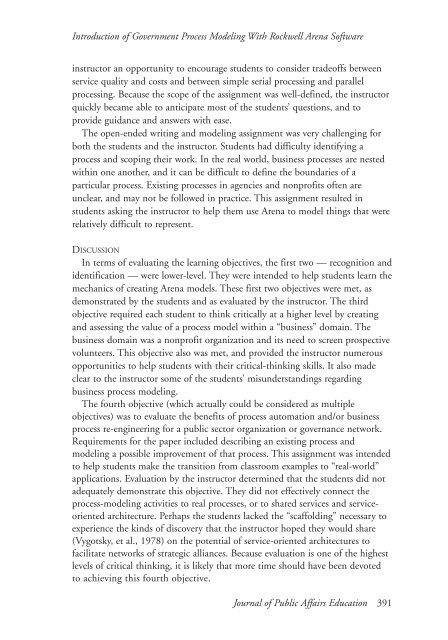journal of public affairs education - NASPAA *The Global Standard ...
journal of public affairs education - NASPAA *The Global Standard ...
journal of public affairs education - NASPAA *The Global Standard ...
- No tags were found...
Create successful ePaper yourself
Turn your PDF publications into a flip-book with our unique Google optimized e-Paper software.
Introduction <strong>of</strong> Government Process Modeling With Rockwell Arena S<strong>of</strong>twareinstructor an opportunity to encourage students to consider trade<strong>of</strong>fs betweenservice quality and costs and between simple serial processing and parallelprocessing. Because the scope <strong>of</strong> the assignment was well-defined, the instructorquickly became able to anticipate most <strong>of</strong> the students’ questions, and toprovide guidance and answers with ease.The open-ended writing and modeling assignment was very challenging forboth the students and the instructor. Students had difficulty identifying aprocess and scoping their work. In the real world, business processes are nestedwithin one another, and it can be difficult to define the boundaries <strong>of</strong> aparticular process. Existing processes in agencies and nonpr<strong>of</strong>its <strong>of</strong>ten areunclear, and may not be followed in practice. This assignment resulted instudents asking the instructor to help them use Arena to model things that wererelatively difficult to represent.DISCUSSIONIn terms <strong>of</strong> evaluating the learning objectives, the first two — recognition andidentification — were lower-level. They were intended to help students learn themechanics <strong>of</strong> creating Arena models. These first two objectives were met, asdemonstrated by the students and as evaluated by the instructor. The thirdobjective required each student to think critically at a higher level by creatingand assessing the value <strong>of</strong> a process model within a “business” domain. Thebusiness domain was a nonpr<strong>of</strong>it organization and its need to screen prospectivevolunteers. This objective also was met, and provided the instructor numerousopportunities to help students with their critical-thinking skills. It also madeclear to the instructor some <strong>of</strong> the students’ misunderstandings regardingbusiness process modeling.The fourth objective (which actually could be considered as multipleobjectives) was to evaluate the benefits <strong>of</strong> process automation and/or businessprocess re-engineering for a <strong>public</strong> sector organization or governance network.Requirements for the paper included describing an existing process andmodeling a possible improvement <strong>of</strong> that process. This assignment was intendedto help students make the transition from classroom examples to “real-world”applications. Evaluation by the instructor determined that the students did notadequately demonstrate this objective. They did not effectively connect theprocess-modeling activities to real processes, or to shared services and serviceorientedarchitecture. Perhaps the students lacked the “scaffolding” necessary toexperience the kinds <strong>of</strong> discovery that the instructor hoped they would share(Vygotsky, et al., 1978) on the potential <strong>of</strong> service-oriented architectures t<strong>of</strong>acilitate networks <strong>of</strong> strategic alliances. Because evaluation is one <strong>of</strong> the highestlevels <strong>of</strong> critical thinking, it is likely that more time should have been devotedto achieving this fourth objective.Journal <strong>of</strong> Public Affairs Education 391
















